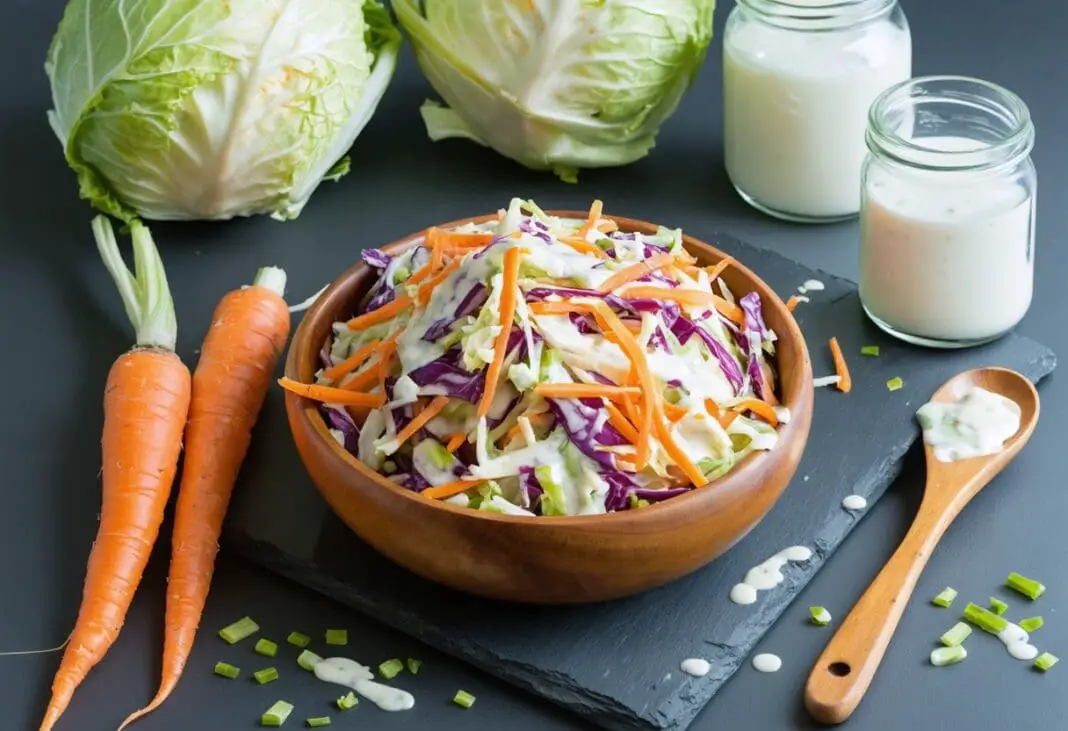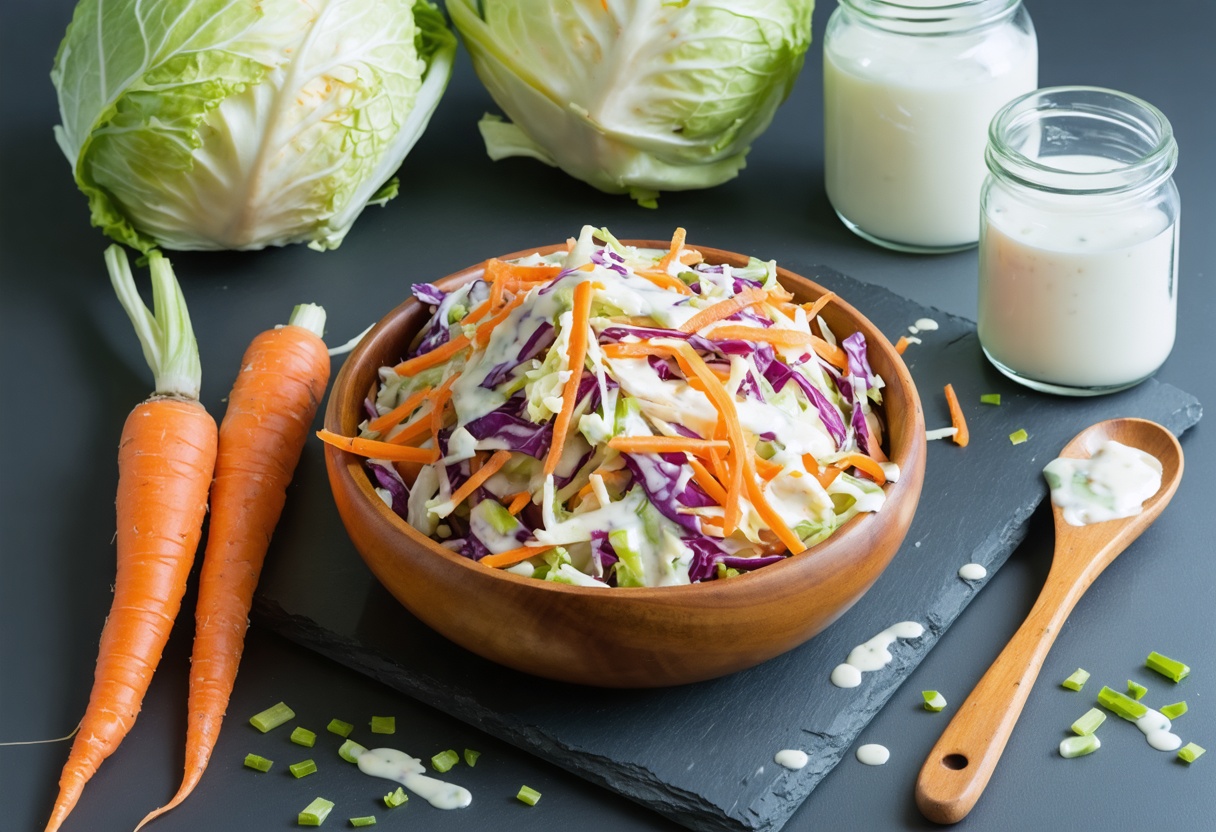Nothing ruins a summer barbecue faster than soggy, watery coleslaw that nobody wants to eat. While coleslaw seems like one of the easiest side dishes to make, most people make the same critical mistakes over and over again. The good news is that once you know what these mistakes are, creating crisp, restaurant-quality coleslaw becomes surprisingly simple.
Skipping the salt treatment ruins everything
The biggest mistake people make with coleslaw happens before they even think about dressing. Raw cabbage contains tons of water, and when you skip the salting step, all that moisture seeps out after you add the dressing. This creates a watery mess at the bottom of your bowl that dilutes all the great taste you worked so hard to create.
The solution is simple but requires patience. Shred your cabbage, then sprinkle it with about one tablespoon of salt per head of cabbage. Let it sit in a colander for at least 30 minutes while water pools at the bottom. After rinsing off the excess salt and drying the cabbage completely, you’ll have crisp, perfectly seasoned leaves that won’t turn your coleslaw into soup.
Using the wrong cabbage type
Not all cabbages work equally well for coleslaw, and picking the wrong variety can doom your dish from the start. Green cabbage is the gold standard because it has the perfect balance of mild taste and structural strength. Its tightly packed leaves hold up beautifully to dressing while staying crunchy for hours.
Red cabbage looks pretty but tends to be more bitter and can turn creamy dressings an unappetizing purple color. Napa cabbage and Chinese cabbage are too delicate and will wilt into mush almost immediately. When shopping, choose heads that feel heavy for their size and have bright, crisp outer leaves. These selection tips from professional chefs can save your coleslaw before you even start cooking.
Drowning vegetables in too much dressing
Even perfectly prepared cabbage can’t survive being drowned in dressing. When you add too much dressing too quickly, the vegetables continue releasing moisture, creating a soggy mess that gets worse over time. The key is using just enough dressing to lightly coat everything without creating a swimming pool.
Start with about 1/4 cup of dressing per 4 cups of vegetables, and add more gradually as needed. Never dress your coleslaw more than 20 minutes before serving, or keep the components separate until the last minute. For outdoor events, consider switching to a vinegar-based dressing that holds up better than mayonnaise-based versions in the heat.
Cutting vegetables the wrong size
Inconsistent cutting creates coleslaw that’s impossible to eat properly. Some bites will be crunchy while others are mushy, and the dressing won’t coat everything evenly. The ideal cut for cabbage is thin, uniform shreds that are easy to eat while still providing great texture.
Remove the outer leaves, quarter the cabbage, cut out the core, then slice thinly with a sharp knife. A mandoline slicer or food processor makes this job much easier and ensures consistent thickness. For carrots, use a box grater rather than chopping them into chunks. Other vegetables like peppers should be cut into thin slices or small pieces that blend well with the cabbage.
Forgetting to balance sweet and sour
Great coleslaw needs the right balance of sweet, tangy, salty, and creamy elements. Too much vinegar makes it harsh and acidic, while too much sugar turns it into dessert. Getting this balance right is what separates restaurant-quality coleslaw from the disappointing stuff that sits untouched at potlucks.
If your coleslaw tastes too acidic, add a small amount of sugar or honey to mellow it out. If it’s too sweet, add more vinegar or lemon juice. Don’t forget about spices like freshly ground black pepper, celery seed, or mustard seed that add complexity without overwhelming the basic taste. Temperature matters too – cold coleslaw tastes more bland, so let it sit at room temperature for about 15 minutes before serving.
Relying on pre-packaged coleslaw mix
Those convenient bags of pre-shredded coleslaw mix in the produce section seem like a time-saver, but they’re actually sabotaging your efforts. These mixes typically contain lower-quality cabbage that’s been sitting around for days, losing moisture and developing an off taste from preservatives.
Pre-cut cabbage starts losing nutrients and becoming limp the moment it’s chopped. If you absolutely must use a pre-packaged mix, examine it carefully and throw away any brown or wilted pieces. Wash it thoroughly, dry it completely, and still follow the salting process. But honestly, shredding fresh cabbage takes just a few minutes with a sharp knife or food processor and makes a huge difference in quality.
Serving coleslaw immediately after mixing
Coleslaw needs time to develop its full potential, but most people serve it right after mixing everything together. The ideal resting time is about 30 minutes in the refrigerator, which gives the vegetables time to absorb the dressing and allows all the seasonings to blend together properly.
Different types of coleslaw have different optimal resting times. Vinegar-based versions actually improve with longer resting periods because the acidity helps preserve the crunch. Mayonnaise-based coleslaws are best served after a shorter rest. If you’re making mayo-based coleslaw well in advance, add just a little dressing initially, then refresh it with more dressing just before serving.
Adding too many strong-tasting vegetables
While variety is good in coleslaw, some vegetables can completely overpower the mild cabbage base. Raw onions, especially red and white varieties, are too sharp and pungent for most coleslaw recipes. Similarly, cucumbers and tomatoes add too much moisture and will make your coleslaw watery and bland.
Hot peppers like jalapeños should be used very sparingly, if at all, because they can dominate the entire dish. Stick to milder additions like shredded carrots, bell peppers, or small amounts of green onions. These vegetables add color and crunch without overwhelming the delicate balance of the basic coleslaw recipe.
Poor storage ruins leftover coleslaw
Even perfect coleslaw can be ruined by improper storage. Coleslaw should never sit out at room temperature for more than two hours, or just one hour if it’s above 90 degrees outside. At outdoor events, keep it in a cooler with ice packs and put it back promptly after serving.
Store leftover coleslaw in airtight containers in the refrigerator, where it will keep for 3-4 days. The quality is best within the first 48 hours though. Vinegar-based versions can actually be frozen for up to two months, but mayonnaise-based coleslaw doesn’t freeze well. When thawing frozen coleslaw, do it in the refrigerator overnight and add a little fresh dressing before serving.
Perfect coleslaw isn’t rocket science, but it does require attention to these common mistakes. By properly salting your cabbage, choosing the right ingredients, and balancing the dressing, you’ll create a side dish that actually gets eaten instead of pushed around on plates. Your next barbecue guests will definitely notice the difference.
Perfect Crispy Coleslaw
Cuisine: American8
servings45
minutes147
kcalThis foolproof coleslaw recipe delivers restaurant-quality results every time with perfectly crisp cabbage and balanced creamy dressing.
Ingredients
1 medium head (about 2 pounds) green cabbage
2 large carrots, peeled
1 tablespoon kosher salt (for drawing out moisture)
1/2 small red onion, finely diced (optional)
3/4 cup mayonnaise
2 tablespoons apple cider vinegar
1 tablespoon Dijon mustard
2 teaspoons granulated sugar
1 teaspoon celery seeds
Directions
- Remove the outer leaves from the cabbage and cut it into quarters. Cut out the tough core from each quarter, then place each quarter flat side down and slice into very thin shreds using a sharp knife. You can also use a mandoline slicer or food processor for more uniform results.
- Place the shredded cabbage in a large colander set over a bowl. Sprinkle the tablespoon of kosher salt evenly over the cabbage and toss gently to distribute. Let the cabbage sit for 30 minutes to draw out excess moisture – you’ll see water pooling at the bottom of the colander.
- While the cabbage drains, shred the carrots using a box grater or food processor with a grating disc. If using red onion, dice it finely and set aside. Prepare the dressing by whisking together mayonnaise, vinegar, mustard, sugar, and celery seeds in a large bowl.
- After 30 minutes, rinse the cabbage thoroughly under cold water to remove excess salt. Drain well, then transfer to clean kitchen towels or paper towels and pat completely dry. The drier the cabbage, the better your coleslaw will be.
- Add the dried cabbage, shredded carrots, and diced onion (if using) to the bowl with the dressing. Using tongs or large spoons, gently toss everything together until the vegetables are lightly and evenly coated with dressing. Don’t overdress – you want coating, not drowning.
- Cover the bowl with plastic wrap and refrigerate for at least 30 minutes before serving. This resting time allows the dressing to penetrate the vegetables and all the seasonings to meld together properly. The properly treated cabbage will stay crisp during this time.
- Before serving, remove the coleslaw from the refrigerator and let it sit at room temperature for about 15 minutes to allow the dressing to come to full strength. Cold temperatures can mute the seasonings, so this brief warming enhances the overall taste.
- Give the coleslaw a final gentle toss to redistribute any dressing that may have settled at the bottom. Taste and adjust seasoning if needed – you can add a pinch more sugar for sweetness or a splash of vinegar for extra tang. Serve immediately alongside your favorite grilled meats or sandwiches.
Notes
- For a time-saving alternative, microwave the shredded cabbage for 60 seconds per 4 cups, then drain in a colander for 10 minutes before cooling completely.
- Vinegar-based coleslaw holds up better at outdoor events – replace mayonnaise with 1/4 cup olive oil and increase vinegar to 1/4 cup.
- Leftover coleslaw keeps for 3-4 days in the refrigerator, though it’s best within 48 hours of making.
- For sweeter coleslaw, increase sugar to 1 tablespoon; for tangier versions, add an extra tablespoon of vinegar.
Frequently Asked Questions About Coleslaw
Q: Why does my coleslaw always turn out watery even when I follow recipes exactly?
A: The most common reason is skipping the salting step. Cabbage naturally contains lots of water that seeps out after cutting. Always salt your shredded cabbage and let it drain for 30 minutes before rinsing and drying thoroughly. This prevents the excess moisture from diluting your dressing.
Q: How far ahead can I make coleslaw without it getting soggy?
A: If you properly salt and dry your cabbage, you can make complete coleslaw up to 4 hours before serving. For longer storage, keep vegetables and dressing separate for up to 24 hours, then combine 30 minutes before serving. Vinegar-based versions hold up longer than mayonnaise-based ones.
Q: Can I use pre-bagged coleslaw mix instead of shredding my own cabbage?
A: While convenient, pre-bagged mixes often contain lower-quality cabbage that’s been sitting for days and may have preservatives that affect taste. If you must use it, examine carefully for brown spots, wash thoroughly, and still follow the salting process. Fresh cabbage only takes a few minutes to shred and tastes much better.
Q: What’s the best way to store leftover coleslaw?
A: Store in airtight containers in the refrigerator for up to 3-4 days, though quality is best within 48 hours. Never leave coleslaw out at room temperature for more than 2 hours (1 hour if above 90°F). Vinegar-based coleslaw can be frozen for up to 2 months, but mayonnaise-based versions don’t freeze well.


